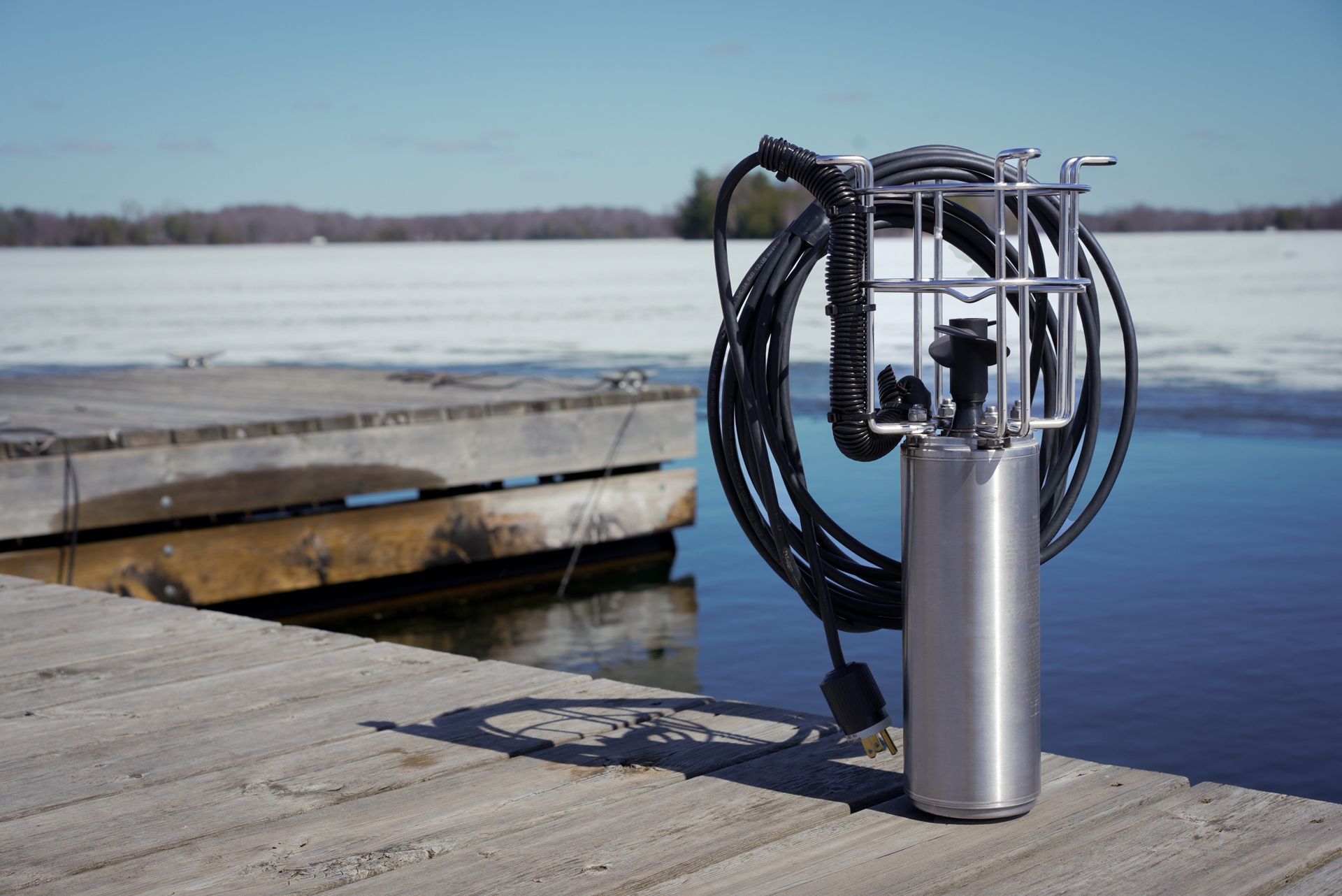How Winter Ice Actually Damages Your Dock (And How a De-Icer Helps)
If you own a dock in Ontario or cottage country anywhere in Canada, you already know winter is not gentle. What many people don’t realise is just how much damage ice can quietly do over a single season, even if everything looks fine in early spring.
This guide breaks down
how ice actually damages docks and
how a dock de-icer, like the
Arbrux De-Icer, helps protect your waterfront.
Why Winter Ice Is So Hard on Docks?
When lake or river water freezes, it expands and forms solid sheets around anything in its way. Over the season, that ice is constantly moving, expanding and contracting. That movement creates serious pressure on:
- Dock legs and cribbing
- Pilings and footings
- Boat lifts and ramps
Ice can warp and split docks, crack structural members and even damage structures on shore. In many Canadian lakes, especially where docks are left in over winter, the combination of ice, fluctuating water levels and wind can cause cumulative structural damage from one season to the next.
- For general background on how ice forms and why it can be hazardous, organisations like the Canadian Red Cross and the Canadian Centre for Occupational Health and Safety provide useful guidance on ice conditions and thickness, including
“Ice Safety: Know when it’s safe to play” and
“Working on or near ice covered water”.
Key Factors in Choosing the Right De-Icer Size
Three Main Ways Ice Damages Docks
1. Ice Expansion
As water turns to ice, it expands. If ice forms tightly around your dock:
- Sideways pressure can crack timbers
- Metal supports can bend
- Fasteners and joints are slowly stressed and loosened
Over many freeze and thaw cycles in a single winter, those small movements add up and shorten the life of your dock.
2. Ice Jacking
Ice jacking happens when:
- Your dock or boat lift becomes locked into the ice
- Water levels drop or rise under the frozen surface
- The ice sheet moves with the water level and lifts or shifts the structure with it
This can:
- Pull legs out of their bases
- Tilt or twist the dock frame
- Damage the connection where the dock meets the shoreline
The result is a dock that no longer sits level, feels unstable underfoot or starts to separate from the shore.
3. Ice Movement and Spring Breakup
In late winter and early spring, large sheets of ice can:
- Drift with wind and current
- Pile up along shorelines
- Push directly into docks, ramps and boat lifts
That moving ice can shear off legs, rip out sections entirely or damage retaining walls and shoreline structures. The Federation of Ontario Cottagers’ Associations (FOCA) notes that changing freeze/thaw patterns and ice jams can increase the risk of flooding and physical damage around waterfront infrastructure, as outlined in their guide on
managing your shoreline under changing conditions.
Signs Your Dock Has Suffered Ice Damage
After the thaw, watch for:
- Legs that no longer sit straight or square
- Dock sections that rock or feel spongy underfoot
- Cracks in beams or joists
- A visible gap or shift where the dock meets the shoreline
- Boat lifts that no longer raise or lower smoothly
If you are noticing these issues on your waterfront, there is a good chance winter ice is already shortening the life of your dock system.
Traditional Ways People Try to Protect Docks
Waterfront owners usually consider a few options:
- Pulling the dock out for winter
- Raising or removing the boat lift
- Leaving everything in and hoping for the best
- Building heavier shore protection to fight ice directly
Pulling a dock out can work in some situations, but it is:
- Time consuming
- Expensive for large or permanent structures
- Not always realistic for marinas or multi-slip systems
This is why many property owners look for a way to protect docks and lifts that stay in the water year-round.
How a Dock De-Icer Helps
A dock de-icer does not heat the water. Instead, it uses a propeller to pull slightly warmer water from deeper below the surface and move it upward around your dock, lift or ramp. This circulation makes it much harder for thick, solid ice to form in that zone.
The
Arbrux De-Icer is designed to:
- Maintain an open-water or thin-ice radius around your dock or boat lift
- Reduce pressure from expanding and shifting ice on key structural points
- Help keep your dock, pilings and lift from becoming locked into solid ice
By maintaining a controlled open-water buffer where it matters most, a de-icer can significantly lower the risk of:
- Ice gripping and jacking dock legs
- Solid ice sheets pushing directly on your dock
- Thick ice bonding to boat lifts and cribs
For many waterfront owners, this means fewer spring repairs and a longer service life for their dock system.
Where De-Icers Make the Biggest Difference
De-icers are especially helpful if:
- You leave your dock in year-round at a cottage or waterfront home
- You have a boat lift that is difficult or costly to remove
- Your dock is in a bay, channel or sheltered area where ice tends to pack in
- You operate a marina with fixed infrastructure and multiple slips
In these situations, a de-icer can be part of a long-term strategy to protect your investment and reduce structural damage season after season.
Using a Dock De-Icer Safely and Responsibly
Any system that keeps water open in winter needs to be used with care. Canadian safety organizations consistently stress that no ice is ever completely safe and that open water or thin ice zones require extra caution.
The Canadian Red Cross, the Canadian Coast Guard, Destination Ontario and the Lifesaving Society all provide valuable information on assessing ice conditions, minimum thickness guidelines and cold-water risks. Helpful resources include:
- Ice Safety: Know when it’s safe to play – Canadian Red Cross
- Ice Safety – Canadian Coast Guard
- Ice safety: 3 steps that could save your life – Destination Ontario
- Cold Water and Ice – Lifesaving Society
FOCA also highlights important legal and safety considerations for any system that creates open water in winter, including the duty to guard and mark openings in the ice, in its resources on
ice safety and changing conditions and its bulletin on
bubblers and safety considerations.
Common best practices when using de-icers include:
- Posting clear “Danger – Open Water” signage on or near the dock
- Marking open water with a visible light at night
- Using a thermostat or timer so you are only de-icing as much as needed
- Communicating with neighbours so everyone is aware of open water areas
When installed and managed correctly, a de-icer can protect your dock and lift while still respecting shared lake use and winter safety for skaters, snowmobilers and other users.
Putting It All Together
Winter ice can:
- Crack and twist dock structures
- Lift and shift legs through ice jacking
- Damage docks, lifts and shoreline structures during breakup
A
well-positioned dock de-icer reduces those forces by
keeping water moving and limiting ice formation around your most vulnerable structures.
If you are looking at your dock this November and hoping to avoid another round of expensive spring repairs, this is the time to act.
You can learn more about how a de-icer works and see specs, mounting options and bundles on the
Arbrux De-Icer product page.






